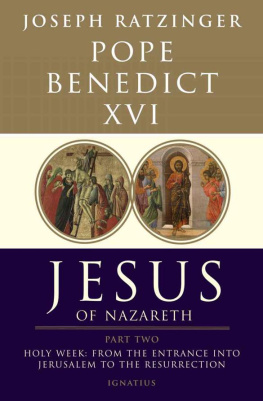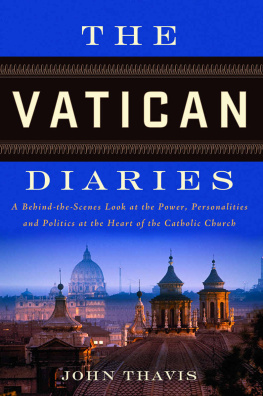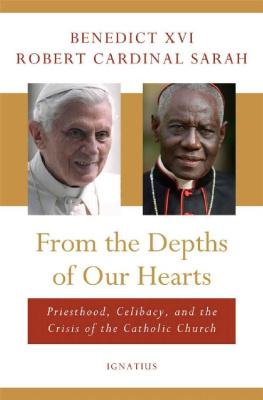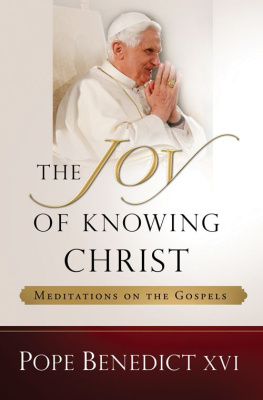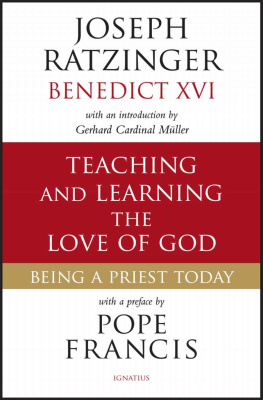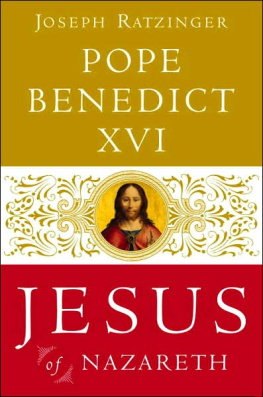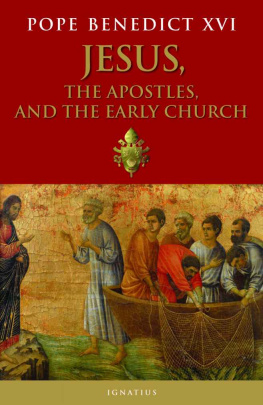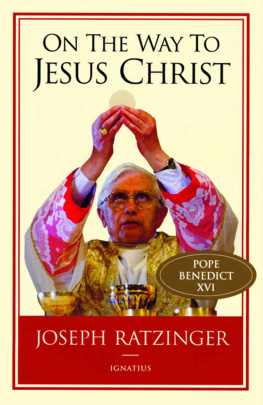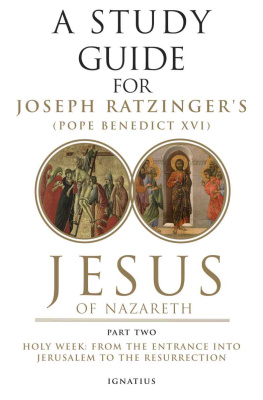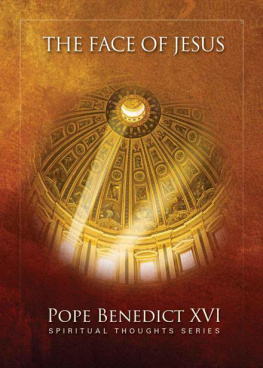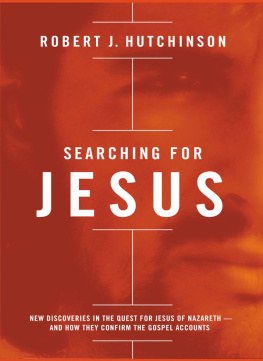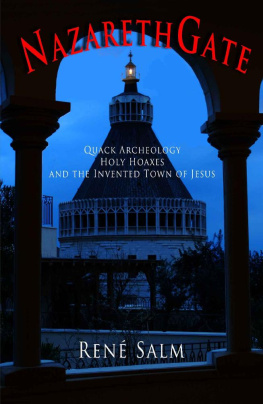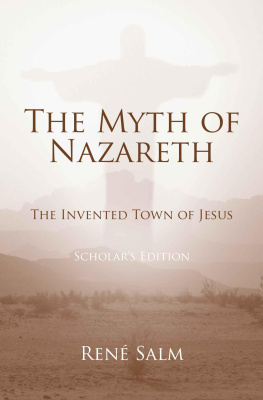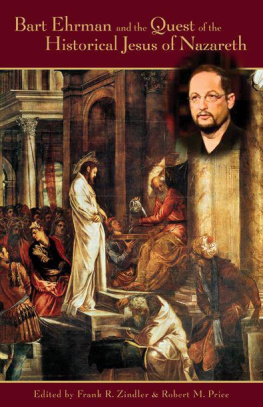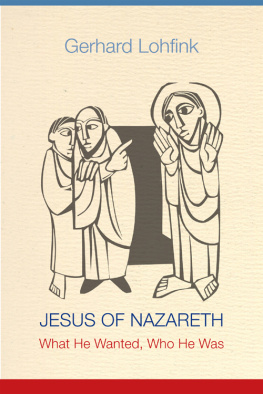JESUS
OF NAZARETH
__________
JESUS
OF NAZARETH
__________
PART TWO
Holy Week
From the Entrance into Jerusalem
to the Resurrection
by
Joseph Ratzinger
Pope Benedict XVI
English translation provided by the
Vatican Secretariat of State
IGNATIUS PRESS SAN FRANCISCO
Original German edition:
Jesus von Nazareth:
Zweiter Teil:
Vom Einzug in Jerusalem
bis zur Auferstehung
All rights reserved
Unless otherwise noted, Scripture quotations (except those within
citations) have been taken from the Revised Standard Version of
the Holy Bible, Second Catholic Edition, 2006. The Revised
Standard Version of the Holy Bible: the Old Testament,
1952, 2006; the Apocrypha, 1957, 2006; the New Testament,
1946, 2006; the Catholic Edition of the Old Testament,
incorporating the Apocrypha, 1966, 2006, the Catholic Edition
of the New Testament, 1965, 2006 by the Division of Christian
Education of the National Council of the Churches of Christ in the
United States of America. All rights reserved.
Translated by Philip J. Whitmore
Front cover art (left):
Christs Passion: Descent from the Cross
and
Front cover art (right):
Christs Appearance Behind Locked Doors
The Maest Altarpiece
Painted 1308-1311 for the Cathedral of Siena
by Duccio di Buoninsegna
Museo dellOpera Metropolitana, Siena, Italy
Scala / Art Resource, New York
Photograph of Pope Benedict XVI by Stefano Spaziani
Cover design by Roxanne Mei Lum
2011 by Libreria Editrice Vaticana, Vatican City
Published in the United States 2011 Ignatius Press, San Francisco
All rights reserved
ISBN 978-1-58617-500-9 (HB)
Library of Congress Control Number 2010937202
Printed in the United States of America
CONTENTS
1 THE ENTRANCE INTO JERUSALEM AND THE
CLEANSING OF THE TEMPLE
The hour of Jesus
You are clean
Sacramentum and exemplumgift and task: The new commandment
The mystery of the betrayer
Two conversations with Peter
Washing of feet and confession of sin
1. The Jewish Feast of Atonement as Biblical Background
to the High-Priestly Prayer
This is eternal life.. .
Sanctify them in the truth.. .
I have made your name known to them.. .
That they may all be one.. .
The first of Jesus words from the Cross: Father, forgive them
Jesus is mocked
Jesus cry of abandonment
The casting of lots for Jesus garments
I thirst
The women at the foot of the Crossthe Mother of Jesus
Jesus dies on the Cross
Jesus burial
A. The Confessional Tradition
Jesus death
The question of the empty tomb
The third day
The witnesses
B. The Narrative Tradition
Jesus appearances to Paul
The appearances of Jesus in the Gospels
ABBREVIATIONS
The following abbreviations are used for books of the Bible:
Acts Acts of the Apostles
Amos Amos
Bar Baruch
1 Chron 1 Chronicles
2 Chron 2 Chronicles
Col Colossians
1 Cor 1 Corinthians
2 Cor 2 Corinthians
Dan Daniel
Deut Deuteronomy
Eccles Ecclesiastes
Eph Ephesians
Esther Esther
Ex Exodus
Ezek Ezekiel
Ezra Ezra
Gal Galatians
Gen Genesis
Hab Habakkuk
Hag Haggai
Heb Hebrews
Hos Hosea
Is Isaiah
Jas James
Jer Jeremiah
Jn John
1 Jn 1 John
2 Jn 2 John
3 Jn 3 John
Job Job
Joel Joel
Jon Jonah
Josh Joshua
Jud Judith
Jude Jude
Judg Judges
1 Kings 1 Kings
2 Kings 2 Kings
Lam Lamentations
Lev Leviticus
Lk Luke
1 Mac 1 Maccabees
2 Mac 2 Maccabees
Mal Malachi
Mic Micah
Mk Mark
Mt Matthew
Nahum Nahum
Neh Nehemiah
Num Numbers
Obad Obadiah
1 Pet 1 Peter
2 Pet 2 Peter
Phil Phillipians
Philem Philemon
Prov Proverbs
Ps Psalms
Rev Revelation (Apocalypse)
Rom Romans
Ruth Ruth
1 Sam 1 Samuel
2 Sam 2 Samuel
Sir Sirach (Ecclesiasticus)
Song Song of Solomon
1 Thess 1 Thessalonians
2 Thess 2 Thessalonians
1 Tim 1 Timothy
2 Tim 2 Timothy
Tit Titus
Tob Tobit
Wis Wisdom
Zech Zechariah
Zeph Zephaniah
The following abbreviations are also used:
CCSL: Corpus Christianorum, Series Latina . Turnhout, 1953. This is a collection of critical editions of all the Latin texts from the first eight centuries of the Christian era. By February 200100, 194 volumes had been published.
PG: Patrologia Graeca , ed. Jacques-Paul Migne, 161 vols., Paris, 1857-1866. This is a collection of ancient Christian sources in Greek.
PL: Patrologia Latina , ed. Jacques-Paul Migne, 217 vols., Paris, 1844-1855. This is a collection of ancient Christian sources in Latin.
TDNT: Theological Dictionary of the New Testament , ed. G. Kittel and G. Friedrich, 100 vols., Grand Rapids: Eerdmans, 1964-1976.
Publishers Note
The Revised Standard Version (RSV) is the preferred translation for scriptural quotations within the text. In some instances, however, in order to reflect as clearly as possible the verbal associations emphasized by the author, it has been necessary to translate directly from the original biblical text.

FOREWORD
At last I am able to present to the public Part Two of my book on Jesus of Nazareth. In view of the predictable variety of reactions to Part One, it has been a source of great encouragement to me that such leading exegetes as Martin Hengel (who sadly has since passed away), Peter Stuhlmacher, and Franz Mussner have strongly confirmed me in my desire to continue my work and to complete the task I had begun. While not agreeing with every detail of my book, they regarded it, in terms of both content and method, as an important contribution that should be brought to fruition.
A further joy for me is the fact that in the meantime this book has, so to speak, acquired an ecumenical companion in the comprehensive volume of the Protestant theologian Joachim Ringleben, Jesus (2008). Anyone who reads both books will see, on the one hand, the great difference in approach and in underlying theological presuppositions through which the contrasting confessional backgrounds of the two authors are concretely expressed. Yet, at the same time, a profound unity emerges in the essential understanding of the person of Jesus and his message. Despite the differing theological viewpoints, it is the same faith that is at work, and it is the same Lord Jesus who is encountered. It is my hope that these two books, both in their differences and in their essential common ground, can offer an ecumenical witness that, at the present time and in its own way, can serve the fundamental common task of Christians.
I also note with gratitude that discussion of the methodology and hermeneutics of exegesis, and of exegesis as a historical and theological discipline, is becoming more lively despite a certain resistance to some recent developments. I consider especially important the book by Marius Reiser Bibelkritik und Auslegung der Heiligen Schrift (2007), which brings together a series of previously published essays, forms them into a whole, and offers important guidelines for new exegetical approaches, without abandoning those aspects of the historical-critical method that are of continuing value.
One thing is clear to me: in two hundred years of exegetical work, historical-critical exegesis has already yielded its essential fruit. If scholarly exegesis is not to exhaust itself in constantly new hypotheses, becoming theologically irrelevant, it must take a methodological step forward and see itself once again as a theological discipline, without abandoning its historical character. It must learn that the positivistic hermeneutic on which it has been based does not constitute the only valid and definitively evolved rational approach; rather, it constitutes a specific and historically conditioned form of rationality that is both open to correction and completion and in need of it. It must recognize that a properly developed faith-hermeneutic is appropriate to the text and can be combined with a historical hermeneutic, aware of its limits, so as to form a methodological whole.
Next page
